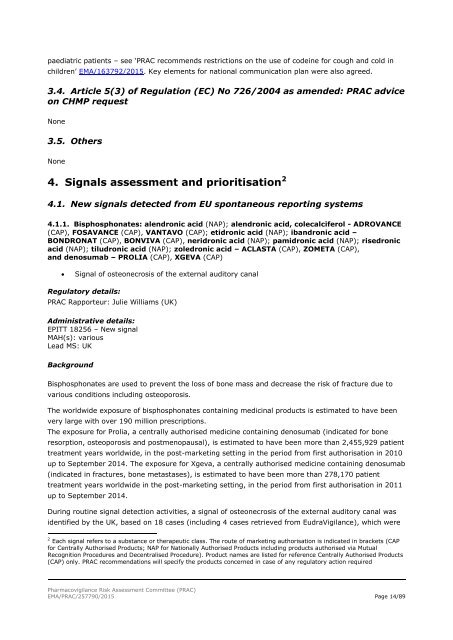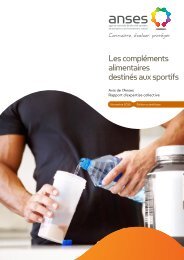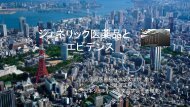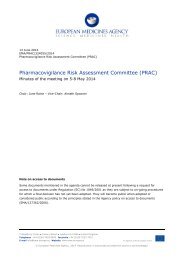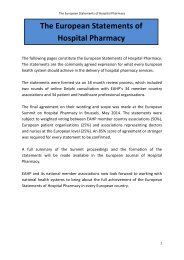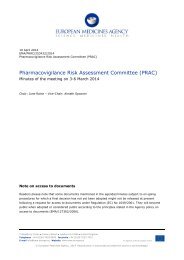WC500185968
WC500185968
WC500185968
You also want an ePaper? Increase the reach of your titles
YUMPU automatically turns print PDFs into web optimized ePapers that Google loves.
paediatric patients – see ‘PRAC recommends restrictions on the use of codeine for cough and cold in<br />
children’ EMA/163792/2015. Key elements for national communication plan were also agreed.<br />
3.4. Article 5(3) of Regulation (EC) No 726/2004 as amended: PRAC advice<br />
on CHMP request<br />
None<br />
3.5. Others<br />
None<br />
4. Signals assessment and prioritisation 2<br />
4.1. New signals detected from EU spontaneous reporting systems<br />
4.1.1. Bisphosphonates: alendronic acid (NAP); alendronic acid, colecalciferol - ADROVANCE<br />
(CAP), FOSAVANCE (CAP), VANTAVO (CAP); etidronic acid (NAP); ibandronic acid –<br />
BONDRONAT (CAP), BONVIVA (CAP), neridronic acid (NAP); pamidronic acid (NAP); risedronic<br />
acid (NAP); tiludronic acid (NAP); zoledronic acid – ACLASTA (CAP), ZOMETA (CAP),<br />
and denosumab – PROLIA (CAP), XGEVA (CAP)<br />
<br />
Signal of osteonecrosis of the external auditory canal<br />
Regulatory details:<br />
PRAC Rapporteur: Julie Williams (UK)<br />
Administrative details:<br />
EPITT 18256 – New signal<br />
MAH(s): various<br />
Lead MS: UK<br />
Background<br />
Bisphosphonates are used to prevent the loss of bone mass and decrease the risk of fracture due to<br />
various conditions including osteoporosis.<br />
The worldwide exposure of bisphosphonates containing medicinal products is estimated to have been<br />
very large with over 190 million prescriptions.<br />
The exposure for Prolia, a centrally authorised medicine containing denosumab (indicated for bone<br />
resorption, osteoporosis and postmenopausal), is estimated to have been more than 2,455,929 patient<br />
treatment years worldwide, in the post-marketing setting in the period from first authorisation in 2010<br />
up to September 2014. The exposure for Xgeva, a centrally authorised medicine containing denosumab<br />
(indicated in fractures, bone metastases), is estimated to have been more than 278,170 patient<br />
treatment years worldwide in the post-marketing setting, in the period from first authorisation in 2011<br />
up to September 2014.<br />
During routine signal detection activities, a signal of osteonecrosis of the external auditory canal was<br />
identified by the UK, based on 18 cases (including 4 cases retrieved from EudraVigilance), which were<br />
2 Each signal refers to a substance or therapeutic class. The route of marketing authorisation is indicated in brackets (CAP<br />
for Centrally Authorised Products; NAP for Nationally Authorised Products including products authorised via Mutual<br />
Recognition Procedures and Decentralised Procedure). Product names are listed for reference Centrally Authorised Products<br />
(CAP) only. PRAC recommendations will specify the products concerned in case of any regulatory action required<br />
Pharmacovigilance Risk Assessment Committee (PRAC)<br />
EMA/PRAC/257790/2015 Page 14/89


